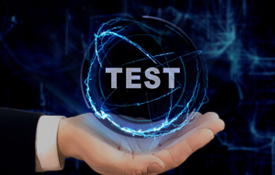Integrated teams
Something we’ve learned in the Covid-19 pandemic is that we have to work together-whatever together means. Very few teams stayed co-located; even teams in the same town worked at home. We’re all working remote. Hopefully all the thinking, tools, work and effort we put into having offshore teams work together benefited us here. Especially soft skills work- communication tools, communication infrastructure, regular check-in’s, the importance of face-to-face video rather than simply an email or a phone call check-in – having those tools in place, and using them for some time, made the working at home/everyone remote go more smoothly. Hopefully by now it’s easy for Agile/Scrum software development teams to keep working together smoothly – even when we’re not in the same room for a daily standup.
But what I’ve been thinking about more lately is the technology integration that goes along with team integration, or task distribution that goes along with integrating dispersed teams. The rise of Full-Stack Development. We take this wide skill set for granted today but it was not too long ago that we had UI designers, engineers and DBAs (database administrators) all doing separate tasks on the same project- and hopefully talking to each other. Full-Stack Development takes one degree of miscommunication or non-collaboration off the table. At the same time, the new distribution of testing tasks has expanded to:
• Developer Unit Testing
• New Functional Testing
• Manual Testing
• Maintaining the Automation
• Automating the new tests
• Executing for Regression suites
• End to End testing
Distribution of tasks we know about, and we also know about the importance of communication and collaboration- and now we’re doing it when everyone is remote. I still think Software Development practices are context-driven. There isn’t one profile for how Dev Teams work. For as many organizations with Full Stack Development that also have Full Stack Testing, where all of the Software testing tasks are consolidated into one team that does all of the new Functional Testing, manual, cross-browser, cross-device testing, maintaining Automation suites and frameworks end to end testing, there are probably more that have distributed the testing tasks across multiple teams, time zones tools and skill sets. Of course, different companies will try different solutions. A mix of internal staff, local staff, distributed staff, outsourcing – I know organizations where this discussion has become irrelevant due to COVID-19 and the staffing crunch happens in the aftermath.

Some organizations are taking any course possible to get the staff to do the job: their internal employees, individual contractors, or entirely outsourced teams. The key to making all this work:
– Working with flexible staffing solutions that even 2 years ago may have seemed undo-able.
– Collaboration is still the most important word. The power of video is stronger than a phone call or email.
– Communication infrastructure needs to be ready for anyone, and be ready for anything
– The most important thing is getting the job done these days, regardless of who does it.
Summary
As we look towards improving communication and adjusting to remote work, it’s a good time to bring up the change in LogiGear Service offerings. This is the start of a new direction for LogiGear Magazine, as we’ve become the LogiGear Group of companies, we look to serve you with content around Software Development, Software Testing and Salesforce CRM development from our own MK Partners. In this issue you’ll see a feature from Michael Larsen on what’s more important scalability or quality? Our blogger of the month features Slack and Salesforce and how to catch up on integrating both within your organization-even more important as we look towards improved communications/processes in this new paradigm. I’m rounding up the pack with a focus on Customer Experience and an example of how quickly bad CX can transform a gift into a burden, based on a recent experience I had. And as always, as we look towards the future if you’re looking for digital transformation assistance feel free to contact us.


















